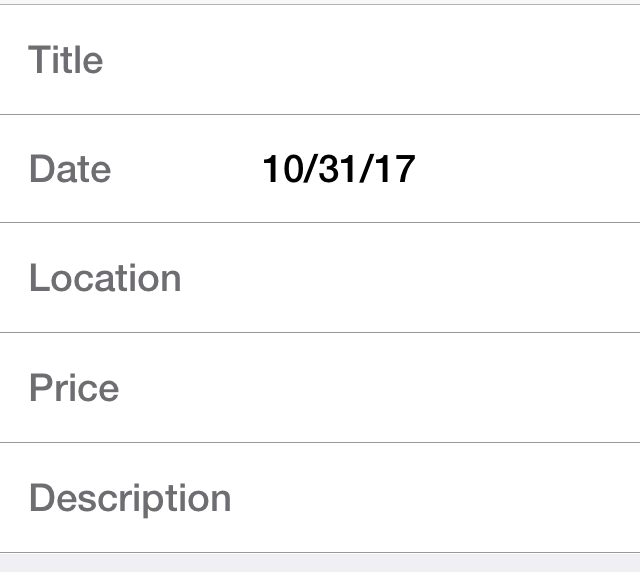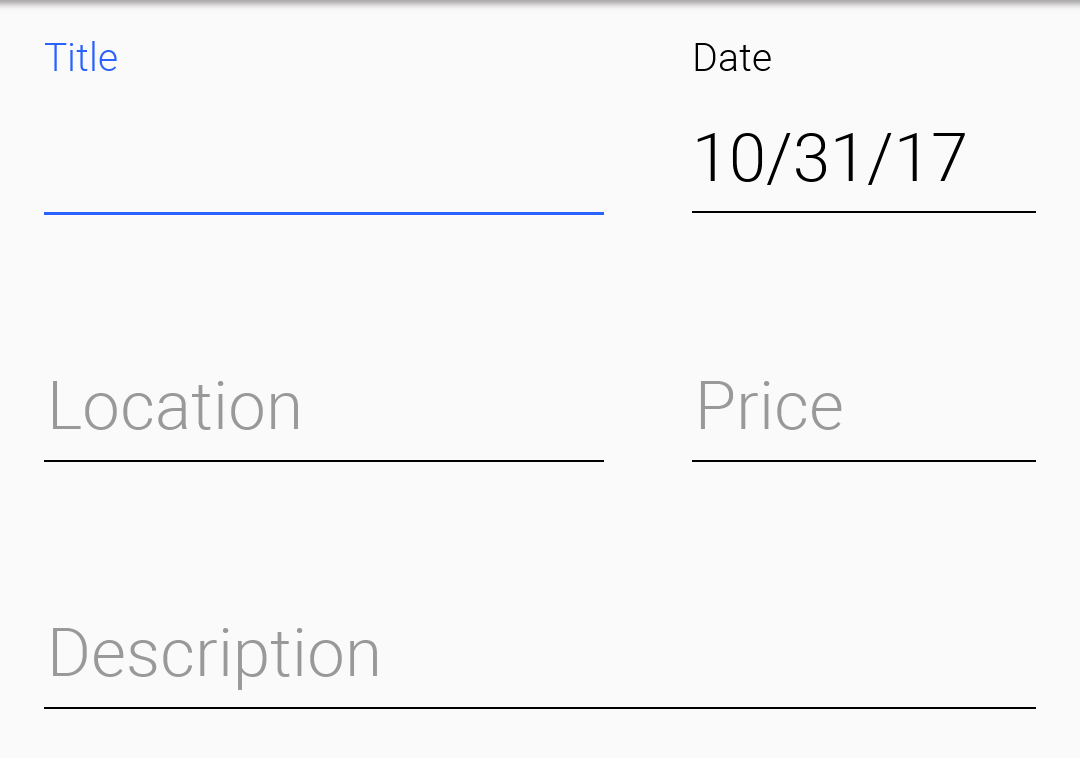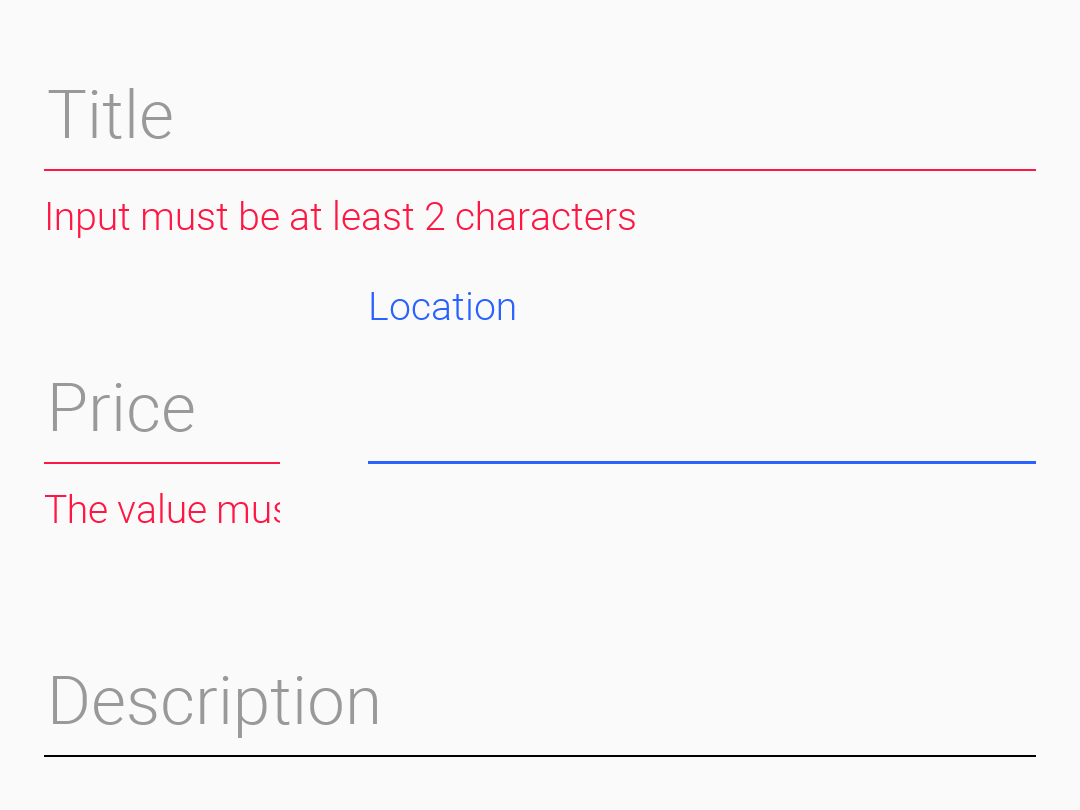- java.lang.Object
-
- com.codename1.ui.layouts.Layout
-
- com.codename1.ui.layouts.TextModeLayout
-
public class TextModeLayout extends Layout
This is a special case layout specifically designed for
InputComponent. When the on top mode of text layout is used this layout acts exactly like a table layout and uses the given constraints. When this mode is false it uses a regular box Y layout mode and orders the elements one on top of the other.One important difference between this layout and the default table layout is that the vertical alignment here is set to
TOPso the error label below doesn't break component alignment if two components are on the same row and only one has an error message.The following code demonstrates a simple set of inputs and validation as it appears in iOS, Android and with validation errors



-
-
Field Summary
Fields Modifier and Type Field and Description TableLayouttableThe underlying table layout can be used freely to create constraints on the fly
-
Constructor Summary
Constructors Constructor and Description TextModeLayout(int rows, int columns)The constructor works like the standard table layout constructor and will behave as such with the on top mode
-
Method Summary
All Methods Instance Methods Concrete Methods Modifier and Type Method and Description voidaddLayoutComponent(Object value, Component comp, Container c)Some layouts can optionally track the addition of elements with meta-data that allows the user to "hint" on object positioning.TableLayout.Constraintcc()Creates a new Constraint instance to add to the layoutTableLayout.Constraintcc(int row, int column)Creates a new Constraint instance to add to the layoutObjectcloneConstraint(Object constraint)TableLayout.ConstraintcreateConstraint()Creates a new Constraint instance to add to the layoutTableLayout.ConstraintcreateConstraint(int row, int column)Creates a new Constraint instance to add to the layoutObjectgetComponentConstraint(Component comp)Returns the optional component constraintDimensiongetPreferredSize(Container parent)Returns the container preferred sizebooleanisAutoGrouping()Automatically invokes theInputComponent.group(com.codename1.ui.Component...)method on the text components in a BoxY layout scenariobooleanisConstraintTracking()If this method returns true, the addLayoutComponent method will be called when replacing a layout for every component within the containerbooleanisOverlapSupported()This method returns true if the Layout allows Components to Overlap.voidlayoutContainer(Container parent)Layout the given parent container childrenbooleanobscuresPotential(Container parent)Some layout managers can obscure their child components in some cases this returns true if the basic underpinnings are in place for that.voidremoveLayoutComponent(Component comp)Removes the component from the layout this operation is only useful if the layout maintains references to components within itvoidsetAutoGrouping(boolean autoGrouping)Automatically invokes theInputComponent.group(com.codename1.ui.Component...)method on the text components in a BoxY layout scenario-
Methods inherited from class com.codename1.ui.layouts.Layout
equals, getChildrenInTraversalOrder, hashCode, overridesTabIndices, updateTabIndices
-
-
-
-
Field Detail
-
table
public final TableLayout table
The underlying table layout can be used freely to create constraints on the fly
-
-
Constructor Detail
-
TextModeLayout
public TextModeLayout(int rows, int columns)The constructor works like the standard table layout constructor and will behave as such with the on top mode- Parameters:
rows- the number of rowscolumns- the number of columns;
-
-
Method Detail
-
addLayoutComponent
public void addLayoutComponent(Object value, Component comp, Container c)
Some layouts can optionally track the addition of elements with meta-data that allows the user to "hint" on object positioning.- Overrides:
addLayoutComponentin classLayout- Parameters:
value- optional meta data information, like alignment orientationcomp- the added component to the layoutc- the parent container
-
cloneConstraint
public Object cloneConstraint(Object constraint)
- Overrides:
cloneConstraintin classLayout
-
getComponentConstraint
public Object getComponentConstraint(Component comp)
Returns the optional component constraint- Overrides:
getComponentConstraintin classLayout- Parameters:
comp- the component whose constraint should be returned- Returns:
- the optional component constraint
-
isConstraintTracking
public boolean isConstraintTracking()
If this method returns true, the addLayoutComponent method will be called when replacing a layout for every component within the container- Overrides:
isConstraintTrackingin classLayout- Returns:
- false by default
-
isOverlapSupported
public boolean isOverlapSupported()
This method returns true if the Layout allows Components to Overlap.- Overrides:
isOverlapSupportedin classLayout- Returns:
- true if Components may intersect in this layout
-
obscuresPotential
public boolean obscuresPotential(Container parent)
Some layout managers can obscure their child components in some cases this returns true if the basic underpinnings are in place for that. This method doesn't take padding/margin etc. into account since that is checked by the caller- Overrides:
obscuresPotentialin classLayout- Parameters:
parent- parent container- Returns:
- true if there is a chance that this layout manager can fully obscure the background, when in doubt return false...
-
removeLayoutComponent
public void removeLayoutComponent(Component comp)
Removes the component from the layout this operation is only useful if the layout maintains references to components within it- Overrides:
removeLayoutComponentin classLayout- Parameters:
comp- the removed component from layout
-
layoutContainer
public void layoutContainer(Container parent)
Layout the given parent container children- Specified by:
layoutContainerin classLayout- Parameters:
parent- the given parent container
-
getPreferredSize
public Dimension getPreferredSize(Container parent)
Returns the container preferred size- Specified by:
getPreferredSizein classLayout- Parameters:
parent- the parent container- Returns:
- the container preferred size
-
createConstraint
public TableLayout.Constraint createConstraint()
Creates a new Constraint instance to add to the layout- Returns:
- the default constraint
-
cc
public TableLayout.Constraint cc()
Creates a new Constraint instance to add to the layout- Returns:
- the default constraint
-
createConstraint
public TableLayout.Constraint createConstraint(int row, int column)
Creates a new Constraint instance to add to the layout- Parameters:
row- the row for the table starting with 0column- the column for the table starting with 0- Returns:
- the new constraint
-
cc
public TableLayout.Constraint cc(int row, int column)
Creates a new Constraint instance to add to the layout- Parameters:
row- the row for the table starting with 0column- the column for the table starting with 0- Returns:
- the default constraint
-
isAutoGrouping
public boolean isAutoGrouping()
Automatically invokes theInputComponent.group(com.codename1.ui.Component...)method on the text components in a BoxY layout scenario- Returns:
- the autoGrouping
-
setAutoGrouping
public void setAutoGrouping(boolean autoGrouping)
Automatically invokes theInputComponent.group(com.codename1.ui.Component...)method on the text components in a BoxY layout scenario- Parameters:
autoGrouping- the autoGrouping to set
-
-